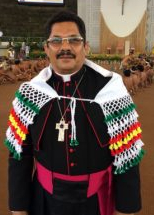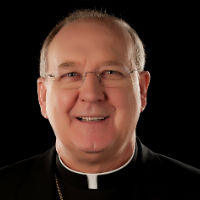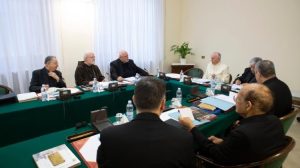
A joyful photograph reflecting the historical changes at the top of the Archdiocese of Luxembourg. Last week, Bishop Leo Wagener (left), became the archdiocese’s first auxiliary bishop, and yesterday Archbishop Jean-Claude Hollerich (right) was created the first cardinal in the country’s history.
Cardinal Hollerich, who also leads the Commision of the Bishops’ Conferences of the European Community (COMECE), consecrated Bishop Wagener on 29th September. The latter’s appointment is undoubtedly related to Cardinal Hollerich’s European duties, while the red hat is at least in part a sign of support for the Catholic community in the small grand duchy. The developments of the last week were certainly momentous.
As of yesterday, each country in the Benelux has its own resident cardinal: Willem Eijk of Utrecht, Jozef De Kesel of Mechelen-Brussels and now Jean-Claude Hollerich of Luxembourg. The latter two were created by Pope Francis, while Cardinal Eijk’s red hat was given to him by Pope Benedict XVI.
Cardinal Hollerich was one of 13 cardinals created yesterday. The College of Cardinals now has 225 members, of which 128 are under the age of 80 and will thus have duties in Rome and can take part in a conclave for the election of a new pope. The newest cardinals, with their title churches, are:
- Miguel Ángel Ayuso Guixot, Cardinal-Deacon of San Girolamo dela Carità
- José Tolentino Calaça de Mendonça, Cardinal-Deacon of Santi Domenico e Sisto
- Ignatius Suharyo Hardjoatmodjo, Cardinal-Priest of Spirito Santo alla Ferratella
- Juan de la Caridad García Rodríguez, Cardinal-Priest of Santi Aquila e Priscilla
- Fridolin Ambongo Besungu, Cardinal-Priest of San Gabriele Arcangelo all’Acqua Traversa
- Jean-Claude Hollerich, Cardinal-Priest of San Giovanni Crisostomo a Monte Sacro Alto
- Álvaro Leonel Ramazzini Imeri, Cardinal-Priest of San Giovanni Evangelista a Spinaceto
- Matteo Maria Zuppi, Cardinal-Priest of Sant’Egidio
- Cristóbal López Romero, Cardinal-Priest of San Leone I
- Michael Czerny, Cardinal-Deacon of San Michele Arcangelo
- Michael Louis Fitzgerald, Cardinal-Deacon of Santa Maria In Portico
- Sigitas Tamkevicius, Cardinal-Priest of Sant’Angela Merici
- Eugenio Dal Corso, Cardinal-Priest of Sant’Anastasia
In the past there has been no hesitation to create new cardinal titles despite the availability of existing ones, but this time around only one new title church has been added: Sant’Egidio for Cardinal Zuppi. A sensible choice as the cardinal is a member of the movement with the same name. Other notable titles given are Sant’Anastasia for Cardinal Dal Corso – until this year the title of Cardinal Godfried Danneels – and Santi Aquila e Priscilla – Cardinal García Rodríguez is the archbishop of Havana, and the previous holder of the title church was his predecessor in the Cuban capital. Cardinal Hollerich’s title church was most recently held by Cardinal José Pimiento de Rodriguez, for a while the oldest cardinal in the world.
Considering Pope Francis’ habit of choosing cardinals from the peripheries, from countries with small Catholic communities or on the fringes of global affairs, the list of nationalities of cardinals has become a lenghty one. Most cardinals are the only ones from their country, while others have a fair number of countrymen in the College of Cardinals. Starting with the countries with the largest number of cardinals, the list is as follows:
- Italy: 42 cardinals
- Spain, United States: 14
- Brazil: 10
- Germany: 8
- France, Mexico, Poland: 6
- Portugal: 5
- Argentina, Canada, India: 4
- Chile, Nigeria, Philippines: 3
- Angola, Australia, Colombia, Congo-Kinshasa, Hong Kong, Indonesia, Lithuania, Netherlands, New Zealand, Peru, South Korea, Switzerland, Thailand, United Kingdom, Venezuela, Vietnam: 2
- Albania, Austria, Bangladesh, Belgium, Bolivia, Bosnia and Herzegovina, Burkina Faso, Cameroon, Cape Verde, Central African Republic, Côte d’Ivoire, Croatia, Cuba, Czech Republic, Dominican Republic, Ecuador, Egypt, El Salvador, Ethiopia, Ghana, Guatemala, Guinea, Haiti, Honduras, Hungary, Iraq, Ireland, Japan, Kenya, Laos, Latvia, Lebanon, Lesotho, Luxembourg, Madagascar, Malaysia, Mali, Malta, Mauritius, Morocco, Mozambique, Myanmar, Nicaragua, Pakistan, Panama, Papua New Guinea, Romania, Saint Lucia, Senegal, Slovakia, Slovenia, Sri Lanka, South Africa, Sudan, Sweden, Tanzania, Tonga, Uganda, Ukraine, Uruguay: 1
So the Italian influence in the College of Cardinals is still great as is that of Europe in general, but this is balanced in the first place by the cardinals from North and South America, but also by the increasing number of far-flung countries from the Caribbean to the Pacific. Pope Francis aims to make the College of Cardinals, which not only elects his successor, but also works with him in the Roman Curia for the global church, to be a reflection of that world. With today’s consistory, he has taken another step in that direction.
Photo credit: Église catholique à Luxembourg – Kathoulesch Kierch zu Lëtzebuerg
 The Holy See today released the full
The Holy See today released the full 
 Also of note is the role of Bishop Karel Choennie of Paramaribo (at right). As his diocese, which covers all of Suriname, is included in the pan-Amazon region, he is an automatic participant, but he has also served on the Presynodal Council, which was tasked with the preparations for the upcoming assembly. Another member of this body is Bishop Erwin Kräutler, the Austrian-born bishop-prelate emeritus of Xingu in Brazil. The 80-year-old prelate presents himself as a close confidant of Pope Francis, but he also supports a number of problematic changes to Catholic teaching and practice.
Also of note is the role of Bishop Karel Choennie of Paramaribo (at right). As his diocese, which covers all of Suriname, is included in the pan-Amazon region, he is an automatic participant, but he has also served on the Presynodal Council, which was tasked with the preparations for the upcoming assembly. Another member of this body is Bishop Erwin Kräutler, the Austrian-born bishop-prelate emeritus of Xingu in Brazil. The 80-year-old prelate presents himself as a close confidant of Pope Francis, but he also supports a number of problematic changes to Catholic teaching and practice.
 (pictured at left giving a homily at the Church of the Frisians in Rome in 2015)
(pictured at left giving a homily at the Church of the Frisians in Rome in 2015)
 On behalf of the Dutch Bishops’ Conference, Bishop Hans van den Hende will attend the meeting in his capacity as the body’s president. The bishop of Rotterdam already met with the pope in December, together with Dr. Wim Deetman, who headed the Dutch investigation into the abuse that took place over past decades. This audience took place out of the pope’s desire to be informed about what the Dutch bishops had done to combat abuse and to compensate the victims. Some have seen that approach as an example for the rest of the world. Bishop van den Hende, in
On behalf of the Dutch Bishops’ Conference, Bishop Hans van den Hende will attend the meeting in his capacity as the body’s president. The bishop of Rotterdam already met with the pope in December, together with Dr. Wim Deetman, who headed the Dutch investigation into the abuse that took place over past decades. This audience took place out of the pope’s desire to be informed about what the Dutch bishops had done to combat abuse and to compensate the victims. Some have seen that approach as an example for the rest of the world. Bishop van den Hende, in  Dr. Deetman, shown at left while meeting Pope Francis, believes that the Dutch investigation and program of compensation is indeed an example of how things should be done in other locations as well.
Dr. Deetman, shown at left while meeting Pope Francis, believes that the Dutch investigation and program of compensation is indeed an example of how things should be done in other locations as well. In 2014, Pope Francis
In 2014, Pope Francis  30 January: Alberto Cardinal Suárez Inda, archbishop emeritus of Morelia, Mexico
30 January: Alberto Cardinal Suárez Inda, archbishop emeritus of Morelia, Mexico In Belgium, Bishop Luc Van Looy of Ghent (pictured at left) has already had his retirement accepted. At 77, he completed a two-year extension to his mandate last year. He is to remain in office until the appointment and installation of his successor. Namur’s Bishop Remy Vancottem is, at 75, also past retirement age, so the southeastern diocese may see a new bishop before the year is out as well.
In Belgium, Bishop Luc Van Looy of Ghent (pictured at left) has already had his retirement accepted. At 77, he completed a two-year extension to his mandate last year. He is to remain in office until the appointment and installation of his successor. Namur’s Bishop Remy Vancottem is, at 75, also past retirement age, so the southeastern diocese may see a new bishop before the year is out as well. In October, the Synod of Bishops will gather again for a special assembly for the Pan-Amazonian region, to discuss the specific challenges for the Church there. The expectations are high, as many assume to what will be decided there, especially on the topic of married priests, will have global consequences. Participation in the special assembly is limited to bishops from the area, which means there is a minute Dutch link, at least when it comes to language, in the person of the bishop of Paramaribo, Msgr. Karel Choennie. Bishop Choennie is a member of the pre-synodal council preparing the special assembly in cooperation with Synod of Bishops’ general secretariat.
In October, the Synod of Bishops will gather again for a special assembly for the Pan-Amazonian region, to discuss the specific challenges for the Church there. The expectations are high, as many assume to what will be decided there, especially on the topic of married priests, will have global consequences. Participation in the special assembly is limited to bishops from the area, which means there is a minute Dutch link, at least when it comes to language, in the person of the bishop of Paramaribo, Msgr. Karel Choennie. Bishop Choennie is a member of the pre-synodal council preparing the special assembly in cooperation with Synod of Bishops’ general secretariat. The decision was not unexpected, but it may have important repercussions for the future work of the Council of Cardinals as well as for Pope Francis’ efforts to reform the Curia. In September, the nine-member Council had requested the pope to reflect on “the work, structure and composition of the Council itself, also taking into account the advanced age of some members”, as today’s
The decision was not unexpected, but it may have important repercussions for the future work of the Council of Cardinals as well as for Pope Francis’ efforts to reform the Curia. In September, the nine-member Council had requested the pope to reflect on “the work, structure and composition of the Council itself, also taking into account the advanced age of some members”, as today’s  The three cardinals are all of advanced age, with Cardinal Pell being the youngest at 77. In fact, only for Cardinal Monsengwo Pasinya would age have been the sole reason to be let go from the Council. In February, the 79-year-old Congolese prelate had a coadjutor archbishop appointed to assist him in his Archdiocese of Kinshasa. In November this coadjutor, Archbishop Fridolin Ambongo Besungu, took over as archbishop of Kinshasa and Cardinal Monsengwo Pasinya retired. The letting go of Cardinals Pell and Errázuriz ,, although in part motivated by their age, is also coloured by their involvement in sexual abuse cases, with Cardinal Errázuriz playing a role in the abuse crisis in Chile and Cardinal Pell currently on trial in his native Australia.
The three cardinals are all of advanced age, with Cardinal Pell being the youngest at 77. In fact, only for Cardinal Monsengwo Pasinya would age have been the sole reason to be let go from the Council. In February, the 79-year-old Congolese prelate had a coadjutor archbishop appointed to assist him in his Archdiocese of Kinshasa. In November this coadjutor, Archbishop Fridolin Ambongo Besungu, took over as archbishop of Kinshasa and Cardinal Monsengwo Pasinya retired. The letting go of Cardinals Pell and Errázuriz ,, although in part motivated by their age, is also coloured by their involvement in sexual abuse cases, with Cardinal Errázuriz playing a role in the abuse crisis in Chile and Cardinal Pell currently on trial in his native Australia. Early last week, Cardinal Müller was in the Netherlands to speak at a congress about recently canonised Pope Paul VI and Vatican II. Katholiek Nieuwsblad (which, as an aside, has recently been expanding its media work abroad, providing translated articles to
Early last week, Cardinal Müller was in the Netherlands to speak at a congress about recently canonised Pope Paul VI and Vatican II. Katholiek Nieuwsblad (which, as an aside, has recently been expanding its media work abroad, providing translated articles to  As announced earlier, the Dutch and Belgian bishops have each chosen an auxiliary bishop from among them to go to Rome: Bishops Rob Mutsaerts and Jean Kockerols (pictured) respectively. A second Belgian bishop was chosen by Pope Francis, however, As in the previous Synod on marriage and family, Ghent’s Bishop Luc Van Looy will also take part in the proceedings. It will probably be his last major role on the world stage, as he will reach the age of 77 at the end of this month, and, on papal request, his retirement has already been postponed by two years. Pope Francis also chose a second Benelux bishop, who is not a member of any bishops’ conference. Archbishop Jean-Claude Hollerich of Luxembourg, who also serves as president of the Commission of the Bishops’ Conferences of the EU, the COMECE.
As announced earlier, the Dutch and Belgian bishops have each chosen an auxiliary bishop from among them to go to Rome: Bishops Rob Mutsaerts and Jean Kockerols (pictured) respectively. A second Belgian bishop was chosen by Pope Francis, however, As in the previous Synod on marriage and family, Ghent’s Bishop Luc Van Looy will also take part in the proceedings. It will probably be his last major role on the world stage, as he will reach the age of 77 at the end of this month, and, on papal request, his retirement has already been postponed by two years. Pope Francis also chose a second Benelux bishop, who is not a member of any bishops’ conference. Archbishop Jean-Claude Hollerich of Luxembourg, who also serves as president of the Commission of the Bishops’ Conferences of the EU, the COMECE.